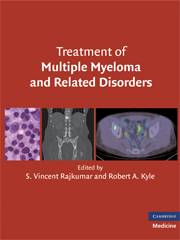Book contents
- Frontmatter
- Contents
- List of Contributors
- 1 DIAGNOSIS AND GENETIC CLASSIFICATION OF MULTIPLE MYELOMA
- 2 STAGING AND RISK-STRATIFICATION OF MULTIPLE MYELOMA
- 3 TREATMENT OF NEWLY DIAGNOSED MULTIPLE MYELOMA
- 4 MAINTENANCE THERAPY IN MULTIPLE MYELOMA
- 5 TREATMENT OF RELAPSED AND RELAPSED/REFRACTORY MULTIPLE MYELOMA
- 6 DIAGNOSIS AND TREATMENT OF MYELOMA BONE DISEASE
- 7 TREATMENT OF MYELOMA-RELATED COMPLICATIONS
- 8 AUTOLOGOUS TRANSPLANTATION FOR MULTIPLE MYELOMA
- 9 ALLOGENEIC STEM CELL TRANSPLANTATION FOR MULTIPLE MYELOMA
- 10 IMMUNOGLOBULIN LIGHT CHAIN AMYLOIDOSIS
- 11 WALDENSTRÖM MACROGLOBULINEMIA/LYMPHOPLASMACYTIC LYMPHOMA
- 12 DIAGNOSIS, RISK-STRATIFICATION, AND MANAGEMENT OF SOLITARY PLASMACYTOMA
- 13 MONOCLONAL GAMMOPATHY OF UNDETERMINED SIGNIFICANCE AND SMOLDERING MULTIPLE MYELOMA
- 14 DIAGNOSIS AND TREATMENT OF POEMS SYNDROME
- Index
- References
6 - DIAGNOSIS AND TREATMENT OF MYELOMA BONE DISEASE
Published online by Cambridge University Press: 11 July 2009
- Frontmatter
- Contents
- List of Contributors
- 1 DIAGNOSIS AND GENETIC CLASSIFICATION OF MULTIPLE MYELOMA
- 2 STAGING AND RISK-STRATIFICATION OF MULTIPLE MYELOMA
- 3 TREATMENT OF NEWLY DIAGNOSED MULTIPLE MYELOMA
- 4 MAINTENANCE THERAPY IN MULTIPLE MYELOMA
- 5 TREATMENT OF RELAPSED AND RELAPSED/REFRACTORY MULTIPLE MYELOMA
- 6 DIAGNOSIS AND TREATMENT OF MYELOMA BONE DISEASE
- 7 TREATMENT OF MYELOMA-RELATED COMPLICATIONS
- 8 AUTOLOGOUS TRANSPLANTATION FOR MULTIPLE MYELOMA
- 9 ALLOGENEIC STEM CELL TRANSPLANTATION FOR MULTIPLE MYELOMA
- 10 IMMUNOGLOBULIN LIGHT CHAIN AMYLOIDOSIS
- 11 WALDENSTRÖM MACROGLOBULINEMIA/LYMPHOPLASMACYTIC LYMPHOMA
- 12 DIAGNOSIS, RISK-STRATIFICATION, AND MANAGEMENT OF SOLITARY PLASMACYTOMA
- 13 MONOCLONAL GAMMOPATHY OF UNDETERMINED SIGNIFICANCE AND SMOLDERING MULTIPLE MYELOMA
- 14 DIAGNOSIS AND TREATMENT OF POEMS SYNDROME
- Index
- References
Summary
INTRODUCTION
Multiple myeloma (MM) is the most common cancer to metastasize to bone, with up to 90% of patients developing bone lesions. The bone lesions are purely osteolytic in nature and do not heal in the vast majority of patients. Up to 60% of patients develop pathological fractures over the course of their disease. Bone disease is a hallmark of MM, and myeloma bone disease differs from bone metastasis caused by other tumors. Although myeloma and other osteolytic metastases induce increased osteoclastic bone destruction, in contrast to other tumors, once myeloma tumor burden exceeds 50% in a local area, osteoblast activity is either severely depressed or absent. The basis for this severe imbalance between increased osteoclastic bone resorption and decreased bone formation has been the topic of intensive investigation over the past several years. These studies have helped to identify novel targets for treating myeloma bone disease and are discussed subsequently in this chapter.
The clinical and economic impact of myeloma bone disease in patients with myeloma can be catastrophic. Saad and coworkers retrospectively evaluated data from patients on the control arms of randomized trials of zoledronic acid to assess the impact of pathological fractures on survival of patients with malignant disease. A total of 3049 patients with metastatic bone disease were included in this study, of which 513 had myeloma. Patients with myeloma had the highest incidence of fracture (43%) over the 21 months of the study compared to patients with breast cancer, prostate cancer, and lung cancer.
- Type
- Chapter
- Information
- Treatment of Multiple Myeloma and Related Disorders , pp. 64 - 75Publisher: Cambridge University PressPrint publication year: 2008
References
- 1
- Cited by



